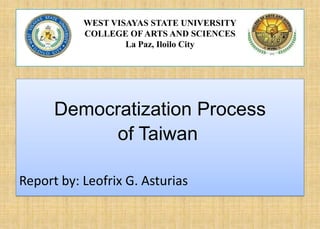
Democratization Process in Taiwan
- 1. WEST VISAYAS STATE UNIVERSITY COLLEGE OF ARTS AND SCIENCES La Paz, Iloilo City Democratization Process of Taiwan Report by: Leofrix G. Asturias
- 2. Statement of the Problem To know the Democratization Process of Taiwan
- 3. Chapter II Objectives of the Study Specific Objectives 1. What are the historical junctures in Taiwan that corresponds phases of democratization? 2. At what stage of democratization is Taiwan today?
- 4. Discussion Body Initial Phase • 1949-government of the Republic of China retreated to Taiwan after its defeat by CCP • Domestic political demands and policy toward the mainland were inextricably bound together • Political institutions could no longer be legitimised by elections held on the mainland in 1947, and political rights on Taiwan could no longer be curtailed by continuing with martial law that was imposed on the mainland to fight the Communists and subsequently extended to the island.
- 5. • Furthermore, a local elite had emerged on Taiwan during the fifty-year occupation of the island by Japan, which, although initially accepting of KMT rule when Taiwan was retrocede to China following Japan’s defeat in World War II in 1945. • Rioting by local Taiwanese against the mainlander-run authorities were brutally suppressed in 1947.
- 6. • The enunciation of the so-called “three nos” policy toward the mainland: “no contact, no compromise, and no negotiations.
- 7. In the Stage of Emerging Phase: • in 1986, when the ruling Kuomintang (KMT) announced a political liberalization program and the opposition formed the Democratic Progressive Party (DPP) • the KMT came to realize that its mainlanderbased power structure had become untenable and began an indigenization program aimed at recruiting native Taiwanese into the party and the government
- 8. • In 1986 it established the DPP, a landmark achievement. • As political liberalization proceeded, numerous new parties emerged: by 1996 there were 82 parties. • Taiwan’s institutions were evolving. Its original constitution, established in accordance with Dr. Sun Yat-sen’s principles, had divided the central government into five branches (Executive, Legislative, Judiciary, Control, and Examination Yuans).
- 9. In the Stage of Advanced Phase: • With increasingly large numbers of Taiwanese travelling to China, where opportunities to trade and invest grew rapidly beginning in the late 1980s, attitudes regarding contact with China began to change. • Many people in Taiwan, especially business people who feared being left out of the “China boom,” began to advocate closer economic ties with the mainland and opposed government restrictions curtailing more extensive business contacts
- 10. • the trade ties that have developed since the late 1980s have been governed more by the needs of business than by the calculations of the government. • Taiwanese investment on the mainland increased by leaps and bounds, and the Taipei authorities began to contemplate allowing some form of direct trade to take place across the Taiwan Strait.
- 11. In the Stage of Consolidation • Taipei in its efforts to participate in various international bodies and non-governmental organizations (NGOs), including the United Nations (UN), World Health Organization (WHO), Asian Development Bank (ADB), Asia Pacific Economic Cooperation (APEC), and International Olympic Committee (IOC), albeit under different appellations.
- 12. • desire of its leadership to maintain or increase non-diplomatic ties with as many countries and international organizations as possible, to expand the so-called “international activity space” for the country • Taipei increased its representation in international bodies in which political entities other than nation-states may be represented. • Taiwan currently belongs to more than 900 international organizations, more than 100 of which Beijing also participates in,
- 13. • Continuing demand on the island for the increase of such “international activity space”, which Beijing is determined to restrict. • the campaign for Taiwan to enter, or re-enter, the UN was taken up by Lee Teng-hui and the KMT in 1993 in response to escalating public and media pressure on this issue, which was first generated by the DPP five years before.
- 14. Conclusion • In the early 1990's, Taiwan was partially through a democratic transition and may now be termed neither authoritarian nor democratic. Taiwan has liberalized its authoritarianism system but not yet institutionalized its democracy. The nation's democratization process is likely to continue as it had begun as a struggle between the democrats and anti-democrats.
- 15. • The compositions of Taiwan’s social classes were transformed, giving rise to a large, affluent and educated middle class. The population was more concentrated in the urban areas, creating new social ties in the society. The nation's education and literacy was dramatically improved. The mass media became freer, and, thanks to new communication technologies, it became more and more difficult for the authoritarian state to control the flow of information.
